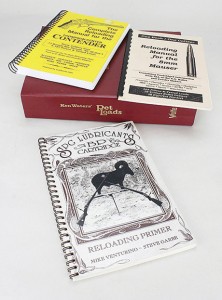 by Art Merrill | Contributing Editor
by Art Merrill | Contributing Editor
Article & All Photo’s
If there is a single most important handloading tool, other than your brain, it is the load data manual or reloading manual. To emphasize its importance I’ve placed it here before discussion of any other tool, and it is the first reloading tool to buy.
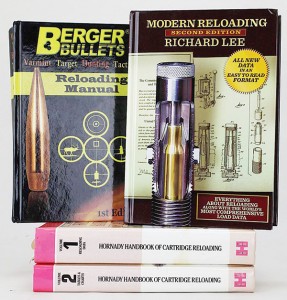 But who makes load data? How do we know the loads are safe? Why does some data in different manuals disagree on maximum and minimum loads? What else is in the manuals besides loads?
But who makes load data? How do we know the loads are safe? Why does some data in different manuals disagree on maximum and minimum loads? What else is in the manuals besides loads?
What’s a ‘load?’
First, when we talk about “loads” we are not referring to just how much powder goes into a cartridge case. A single load is the combination of a specific powder, a specific amount (weight) of that powder, a specific bullet and a specific primer, and sometimes even a specific maker’s cartridge case. Change one of these variables and you have a different load.
Unlike tables on bullet trajectories and energies that are software-driven mathematical computations, a lot of load data is derived by actually shooting the listed loads in special barrels that directly measure the pressure the loads produce within the chamber. Publishers of reloading manuals who also manufacture bullets or powders do their own testing and all will say that their loads are “within SAAMI pressure limits.”
SAAMI is the Sporting Arms and Ammunition Manufacturing Institute, Inc., a private business that serves the firearms industry by establishing agreed-upon standards for sporting firearms and ammunition. Among other things, SAAMI sets standards for pressure testing ammunition and establishing maximum pressure limits for specific cartridges. SAAMI also sets standards for cartridge and chamber dimensions.
An identical load fired in two different test barrels can produce slightly different pressures – that’s just the real world of variables—so reloading manuals will differ slightly in maximum listed loads. Even though published loads are below maximum safe pressure limits in those test barrels, when you shoot that load you have already introduced a new variable: your firearm. Your chamber or headspace may differ enough to cause higher (or lower) pressures to occur using the identical load printed in the manual. Another immediate variable is your handloading technique—how tightly you crimp the bullet, for example, or how far out you seat it. For such reasons we never start near maximum when developing a load.
Not just loads
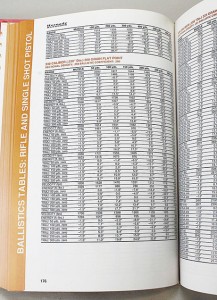
Some manuals include trajectory tables. Keep your old manuals; even though Hornady has superseded this older manual, the info is still relevant.
Which brings us to what else is inside the reloading manual that we need to know? One reason I recommend you buy a manual first is that nearly all start with a “how-to” education in basic handloading. Yes, each manual will focus on that particular manufacturer’s bullets or powders or tools, but that doesn’t mean the information is applicable only to those tools or components. Each particular manual will differ in the detail and quantity of “how-to,” and may or may not delve into other subjects. Taking the Berger Bullets Reloading Manual as an example, the first quarter of its 829 pages is not load data. After covering handloading basics, there’s a lot of technical information on bullet design and form factor, how to utilize a chronograph’s measurement of standard deviation, brief descriptions of shooting sports competitions like High Power and Bench Rest, and more.
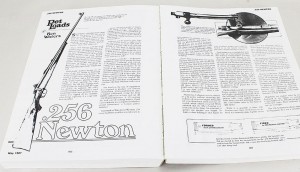
A collection of Ken Waters’ handloading articles, available from Wolf Publishing (riflemagazine.com), includes loads for obsolete calibers not found elsewhere.
So, which one should be your first manual? Really, it comes down to your personal taste in how the manual is organized; or if you have a particular favorite brand of tools or components, you may want that maker’s manual. In addition to listing load data, your manual should also tell you a specific cartridge’s maximum overall length (abbreviated COAL or COL) and maximum case length before trimming is required. It should suggest a trim-to length for cases or list the SAAMI minimum case length. And it should list a bullet’s ballistic coefficient (BC), which you can cross reference on tables (sometimes included) or plug into a ballistics calculator (purchased software or free online) to find the bullet’s downrange trajectory at a given velocity. Because rifling twist rates affect a bullet’s performance, newer manuals, especially from bullet makers, often include minimum or optimal twist rates for specific bullets.
What’s the diff?
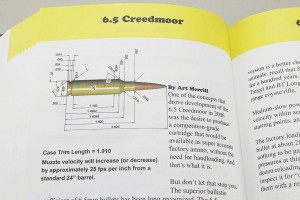
Reloading manuals, such as this Berger Bullets manual, should include maximum case length and trim-to case length.
Such preambles aside, here is a systematic way of approaching different reloading manuals to understand what information you are buying:
- Bullet manufacturers like Berger, Hornady, Sierra and Speer publish manuals that feature only their own bullets, and they list loads with various powders.
- Powder manufacturers like Hodgdon list loads with only their powders but with various makes of bullets. Companies like Winchester that make both bullets and powders feature their own products, as well.
- Lee and Lyman make reloading tools but do not make bullets or powder. The Lee and Lyman manuals include bullet and powder combinations not found elsewhere. Both Lee and Lyman make molds for casting your own lead bullets, and each has load data specific to those DIY bullets with various powders.
- Sources of load data other than manuals, such as gun magazines, LoadData.com and publications like “Pet Loads” by Ken Waters have no product jealousies, so they list loads outside the manufacturers’ boxes.
Note that, if the load data source does not manufacture bullets or powders, they also may not do any real life, direct-read pressure testing of their loads. Instead, they develop safe loads by measuring bullet velocities over a chronograph and inspecting fired cases, an indirect means of measuring pressure that you, too, can and should perform.
A single reloading manual typically includes a few dozen loads each for scores of different calibers. Others focus on a single caliber and gather together load data from bullet and powder makers’ manuals on that single caliber. Still others are specialized in other ways. As examples, a reloading manual for the T/C Contender is specific to that handgun because it chambers rifle cartridges and oddball cartridges used in Silhouette competition, and there are also reloading manuals specific to blackpowder rifle cartridges.
Because makers are constantly introducing new bullets, powders and cartridges, reloading manual publishers produce a new edition every few years and it’s a good idea to update yours. But don’t toss out your old reloading manual because it is still good reference material. The day will come when someone will give you a bunch of unidentified, discontinued bullets for reloading. How can you safely reload them if you don’t know what they are? You weigh them and note their shape, and then cross reference them to similar or identical bullets in older manuals to get a “ballpark” safe starting load.
Other tools
You have online resources, too. Hornady, Winchester and Hodgdon all have free online load data and/or an online ballistics calculator, the latter based on a bullet’s BC and starting velocity. Loaddata.com lists more than 289,000 loads; accessing it requires a membership fee, and the information is printable.
Here are the URLs:
- winchester.com/learning-center/ballistics-calculator/Pages/ballistics-calculator.aspx
- hornady.com/ballistics-resource/ballistics-calculator
- hodgdonreloading.com/
- loaddata.com
Next month let’s look at reloading presses, our next logical purchase.

